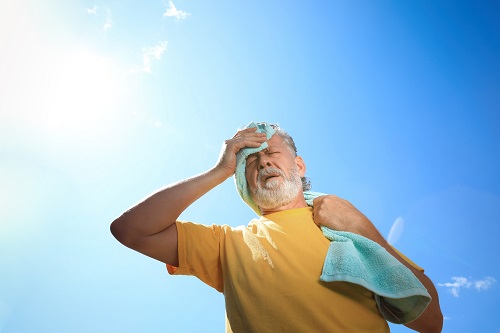Author: Lindsey Ulrich

"Watch out for people who have a hard time regulating their body temperature, such as kids and older adults."
Heatstroke is a life-threatening emergency that starts as heat exhaustion.
“When temperatures rise, it is important to stay well hydrated, rest in a cool or shaded place, wear light and loose clothing, and avoid alcohol,” said Christine Perry, DO, clinical director of the emergency department at McLaren Greater Lansing.
How to recognize and treat heat exhaustion
Symptoms of heat exhaustion include:
- Muscle cramps
- Headache
- Dizziness and confusion
- Loss of appetite or feeling sick
- Excessive sweating and pale, clammy skin
- Fast breathing or pule
- High temperature
- Excessive thirst
If someone is exhibiting signs of heat exhaustion, here's what to do:
- Move them to a cool place
- Get them to lie down and raise their feet
- Have them drink water
- Cool their skin with water or ice
- Stay with them for 30 minutes to make sure their symptoms decrease
“Watch out for people who have a hard time regulating their body temperature, such as kids and older adults,” said Dr. Perry. “Because both kids and older adults have thinner skin and don’t sweat as well, it’s important to be cognizant of the risk and to check on our vulnerable neighbors and friends during the warm season.”
How to recognize heatstroke
Heat exhaustion can easily become heatstroke if not tended to. Heatstroke includes all the above heat exhaustion symptoms, plus:
- A temperature over 104 degrees Fahrenheit
- Irrational behavior or hallucinations
- Confusion
- Rapid, shallow breathing
- Seizures and loss of consciousness
- Dry skin
Call 911 or head to the nearest emergency department if you see someone experiencing the symptoms above. In the meantime, care for them by doing the following:
- Move them to a cooler area
- Loosen clothing or remove any sweaty clothing
- Apply cool, wet towels to the face, neck, chest, and limbs
- Apply ice to underarms, wrists, and groin
- Fan them
- Offer cool water or sports drinks every 15 minutes if the person is conscious
To learn your personal risk factors, make an appointment with a primary care physician. See McLaren doctors who are accepting new patients.
More articles on health and wellness.